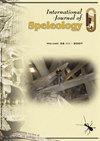Microbiological study in a gneissic cave from Sri Lanka, with special focus on potential antimicrobial activities
IF 1.3
4区 地球科学
Q3 GEOSCIENCES, MULTIDISCIPLINARY
引用次数: 0
Abstract
The emergence of antibiotic resistance is a global health crisis, thus the search for novel antimicrobial compounds has become a continuous necessity. Underexplored and extreme environments, such as cave ecosystems, have been identified as a promising potential source for the discovery of novel microorganisms with novel antimicrobial compounds (AMC). This study presents the first cave microbiological investigation in Sri Lanka, with a special preference for bioprospecting of novel AMC. The cave sediment characterization demonstrated the presence of close to strong acidic conditions (pH 3.1 – 3.3) and thus indicates the possibility of isolating acidophilic microorganisms. Eight cave wall/ceiling fungal strains were isolated from Sthreepura Cave - Kuruwita and identified using both morphological and ribosomal Internal Transcribed Spacer (ITS) region sequence analysis. Interestingly, four fungal isolates (Penicillium panissanguineum, P. cremeogriseum, Aspergillus bertholletius and Trichoderma yunnanense) were found to be the first records in Sri Lanka. Of these eight isolates, three showed antimicrobial activity (AMAs) against at least one of the five tested human pathogens in preliminary screening, while A. fumigatus (SKW 404) strain showed the highest AMA against Staphylococcus aureus (ATCC 11778) assessed by agar culture plug method on Muller Hinton Agar (MHA). Crude Ethyl Acetate (EtOAc) fraction of both mycelial and Potato Dextrose Broth (PDB) extracts of A. fumigatus demonstrated similar bioactive metabolic profiles with four corresponding chemical fractions [Rf = 0.47, 0.56, 0.65, 0.82; EtOAc: Hexane (4:1, v/v)] in TLC: agar overlay bioassay. The present study indicates that there is potential for discovering novel Sri Lankan deep cave microorganisms and bioprospecting of their novel bioactive compounds. Hence, further island-wide in-depth cave microbiological investigations are required for a better understanding of the Sri Lankan cave microbiology.斯里兰卡片麻岩洞穴微生物学研究,特别关注潜在的抗菌活性
抗生素耐药性的出现是一场全球性的健康危机,因此寻找新型抗菌化合物已成为持续的必要。未被充分探索的极端环境,如洞穴生态系统,已被确定为发现具有新型抗菌化合物的新型微生物(AMC)的一个有前途的潜在来源。本研究首次在斯里兰卡进行洞穴微生物调查,特别关注新型AMC的生物勘探。洞穴沉积物的特征表明存在接近强酸的条件(pH 3.1–3.3),因此表明分离嗜酸微生物的可能性。从Sthreepura cave-Kuruwita中分离出8株洞穴壁/天花板真菌菌株,并通过形态学和核糖体内部转录间隔区(ITS)区域序列分析进行鉴定。有趣的是,在斯里兰卡发现了四种真菌分离株(帕尼桑青霉菌、克里毛灰霉菌、白曲霉和云南木霉)。在这八个分离株中,有三个在初步筛选中对五种测试的人类病原体中的至少一种表现出抗微生物活性(AMA),而烟曲霉(SKW 404)菌株对金黄色葡萄球菌(ATCC 11778)表现出最高的抗微生物活性,这是通过Muller Hinton琼脂(MHA)琼脂培养塞法评估的。烟曲霉菌丝体和马铃薯右旋糖酐肉汤(PDB)提取物的粗乙酸乙酯(EtOAc)组分在TLC:琼脂覆盖生物测定中表现出相似的生物活性代谢特征,具有四个相应的化学组分[Rf=0.47、0.56、0.65、0.82;EtOAc:己烷(4:1,v/v)]。目前的研究表明,有可能发现新的斯里兰卡深洞穴微生物,并对其新的生物活性化合物进行生物勘探。因此,需要在全岛范围内进行进一步深入的洞穴微生物调查,以更好地了解斯里兰卡洞穴微生物。
本文章由计算机程序翻译,如有差异,请以英文原文为准。
求助全文
约1分钟内获得全文
求助全文
来源期刊

International Journal of Speleology
地学-地球科学综合
CiteScore
3.10
自引率
23.10%
发文量
12
审稿时长
>12 weeks
期刊介绍:
The International Journal of Speleology has the aim to get cave and karst science known to an increasing number of scientists and scholars. The journal therefore offers the opportunity to all scientists working in and on karst to publish their original research articles or their review papers in an open access, high quality peer reviewed scientific journal at no cost. The journal offers the authors online first, open access, a free PDF of their article, and a wide range of abstracting and indexing services.
 求助内容:
求助内容: 应助结果提醒方式:
应助结果提醒方式:


